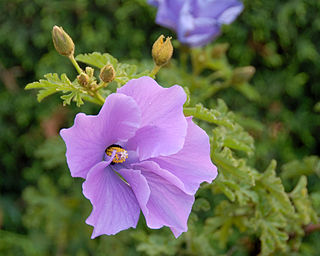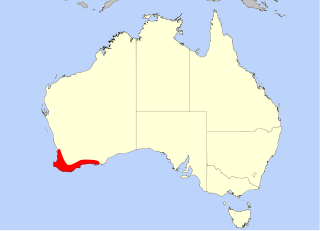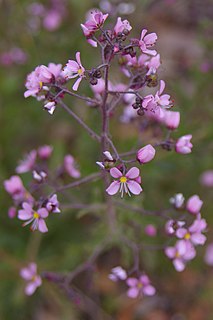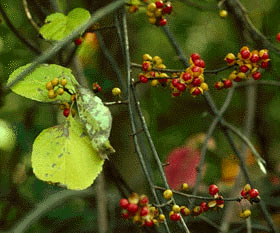
Melaleuca huegelii, commonly known as chenille honey-myrtle, is a plant in the myrtle family, Myrtaceae and is endemic to the south-west coastal areas of Western Australia. It has small, almost scale-like leaves and flower spikes sometimes more than 100 millimetres (4 in) long on the ends many of its branches.

Alyogyne huegelii is a flowering plant found in the Southwest botanical province of Western Australia, extending along its entire coastline.

Verticordia huegelii, commonly known as variegated featherflower, is a flowering plant in the myrtle family, Myrtaceae and is endemic to the south-west of Western Australia. It is a sometimes an erect shrub, sometimes sprawling to almost prostrate. It has linear leaves and very feathery flowers in spring. The flowers are usually cream-coloured or white, becoming pinkish and reddish or maroon as the flowers age, giving a variegated appearance to the display.

Cyrtostylis huegelii, commonly known as the western common gnat orchid or midge orchid, is a species of orchid endemic to Western Australia. It usually has a single rounded leaf and a flowering spike with up to fifteen pale green and dull red flowers with a purplish, shelf-like labellum. Some authorities regard C. huegelii as a synonym of Cyrtostylis reniformis var. huegelii.

Stackhousia is a genus of annual and perennial plants in the family Celastraceae that are native to Australia, New Zealand, Malesia and Micronesia. The genus was first described by James Edward Smith in Transactions of the Linnean Society of London in 1798.

Drosera huegelii, the bold sundew, is an erect perennial tuberous species in the carnivorous plant genus Drosera that is endemic to Western Australia. It grows in sandy soils in winter-wet depressions and margins of swamps and occurs along the south-west coast of Australia. D. huegelii produces small, bell-shaped leaves along an erect stem that can be 10–50 cm (4–20 in) tall. White to cream-coloured flowers emerge from June to September.

Cyrtostylis reniformis, commonly known as common gnat-orchid, is a species of orchid endemic to eastern Australia. It usually has a single kidney-shaped leaf and a flowering spike with up to eight reddish flowers with a shelf-like labellum. Cyrtostylis huegelii is a similar species occurring in Western Australia and which some authorities regard as a synonym of Cyrtostylis reniformis var. huegelii.

Grevillea huegelii, commonly known as comb grevillea, is a shrub that is endemic to southern Australia. The species was first formally described by botanist Carl Meissner in Plantae Preissianae in 1845.

Stackhousia monogyna, commonly known as creamy stackhousia or creamy candles, is a perennial herb species in the family Celastraceae. It is native to Australia. Plants grow to 70 cm (28 in) high and produce a terminal spike of white, cream or yellow flowers between August and January in the species native range.

Diplopeltis hueglii is a shrub species in the soapberry family, Sapindaceae. It is endemic to Western Australia. Plants grow to between 0.1 and 1.5 metres high. White, pink or purple flowers are produced between April and December in the species native range.
Calothamnus huegelii is a plant in the myrtle family, Myrtaceae and is endemic to the south-west of Western Australia. It is an erect shrub growing to a height of about 2 metres (6.6 ft) with red flowers in autumn or September.

Acacia huegelii is a shrub belonging to the genus Acacia and the subgenus Phyllodineae native to Western Australia.

Caladenia huegelii, commonly known as the grand spider orchid is a species of orchid endemic to the south-west of Western Australia. It has a single, hairy leaf and up to three relatively large red, green and cream-coloured flowers which have "split-hairs" on the sides of the labellum.

Stackhousia clementii is a species of plant in the Celastraceae family.
Stackhousia dielsii, commonly known as yellow stackhousia, is a species of plant in the Celastraceae family.

Stackhousia muricata is a species of plant in the Celastraceae family.
Stackhousia pubescens, commonly known as downy stackhousia, is a species of plant in the Celastraceae family.
Stackhousia scoparia is a species of plant in the Celastraceae family.
Stackhousia stratfordiae is a species of plant in the Celastraceae family.
Stackhousia umbellata is a species of plant in the Celastraceae family.















